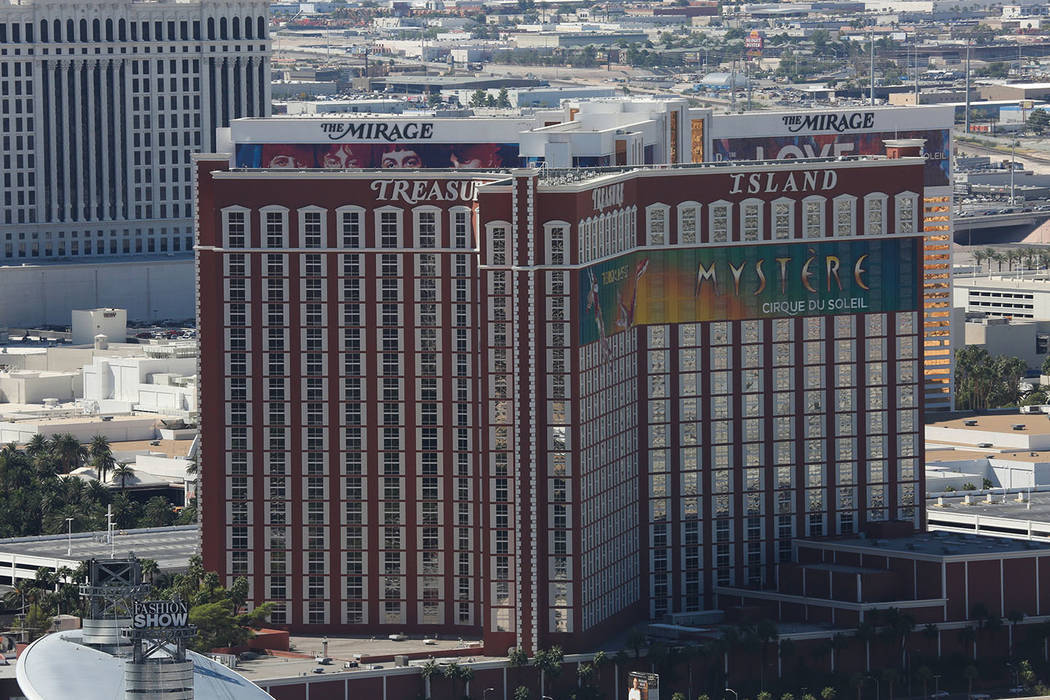Did Nevada casinos file emergency plans on time? Many found on wrong list
Editor’s note: This is an updated version of a Dec. 18, 2019 story:
The state’s top emergency management official says his agency is attempting to “improve” its tracking of casino emergency response plans, as new oversight concerns have surfaced.
Justin Luna, chief of the Nevada Division of Emergency Management, signaled the action when he informed the Sahara Las Vegas in a Dec. 19 email that it is not on a pared-down list of resorts that failed to update security plans.
Luna said a “further review” found that the Sahara Las Vegas submitted its plan to the division on Oct. 3, nearly four weeks before a Nov. 1 deadline.
“We apologize for any inconvenience and appreciate your patience as we work to improve the process,” Luna wrote.
State officials have had trouble tracking casino emergency plans two years after a Review-Journal investigation exposed serious oversight flaws.
This comes amid a Dec. 17 shooting at a Montana casino that left three people dead and another injured.
The 2017 investigation found that the emergency management division had little resources to review and monitor the security plans, including those at Mandalay Bay, where a gunman fired into an outdoor music festival. Emergency response plans also cover fires, acts of terrorism, cyberattacks, communicable disease outbreaks and natural disasters.
In November, the emergency management division put together a list of 24 resorts it said did not meet the Nov. 1 deadline to submit updated plans. The list was one-fourth of the 91 casinos in the state required to maintain plans under a new law to improve years of lax monitoring and enforcement.
Within weeks, the list dropped to three with little explanation about the discrepancy in casinos reported out of compliance.
Conflicting casino numbers
The agency, as mandated by the new law, referred the list to the Nevada Gaming Control Board on Nov. 14 for possible disciplinary action — and provided the Review-Journal with a copy in response to a records request.
Letter from Justin Luna to ... by Las Vegas Review-Journal on Scribd
But several casinos contacted by the newspaper insisted that they had filed updated plans by the deadline, which conflicted with the information supplied by state officials.
Then, following Review-Journal inquiries about the discrepancies, the emergency management division reduced its list of noncompliant casinos to just three: Treasure Island and Sahara Las Vegas on the Strip and Terrible’s in Jean. A Treasure Island spokeswoman said the resort believed it had updated its plan and would check with the state to see why it was on the list. A Terrible’s executive said the resort filed its plan in late October but was told it needed to make some changes and resubmit it.
Kim Yoko Smith, an emergency management division spokeswoman, refused to explain why the original list of 24 was inaccurate and whether all of the 21 casinos removed from the list had met the Nov. 1 deadline.
“DEM provided a list to the Gaming Control Board, and they reached out to the resorts that were not in compliance, and most have sent in their emergency response plans,” Smith said in an email. “We are actively working with the others to receive theirs.”
Casino executives said an emergency management division staffer went back and reviewed the plans with the intent to revise the list. One source said the division indicated that a database error might have led to the original longer list.
Gaming Control Board officials repeatedly refused to discuss their enforcement efforts, arguing they are confidential.
But the Review-Journal obtained a copy of a Dec. 9 letter the board sent to one casino.
Gaming Control board 2019 l... by Las Vegas Review-Journal on Scribd
“As a gaming licensee, please be advised that failure to comply with any provision of the Nevada Gaming Control Board Act, including its emergency response plan requirements discussed above, ‘could be grounds for suspension or revocation of a license,’” wrote James Taylor, chief of enforcement for the board.
Taylor said it was “imperative” resorts comply with the new law, and he gave them until Dec. 31 to submit their latest versions to the emergency management division.
Nevada Public Safety Director George Togliatti, whose agency oversees the emergency management division, said he hoped that any resort that did not meet the deadline was the result of an oversight on the resort’s part.
“It’s not a list you want to be on,” Togliatti said. “You want the public to understand the intent of this law is to prepare for an emergency or worst case scenario.
Togliatti said most resorts have established strong lines of communication with local emergency managers.
The plans, which by law are confidential and not available to the public, provide sensitive internal information about the resorts, including evacuation routes, to help customers and first responders deal with an emergency.
“When a major incident happens, it’s no time to start looking for the plans,” said former Assemblyman John Oceguera, a retired North Las Vegas assistant fire chief who sponsored the original 2003 oversight law. “I know our local first responders do a good job of familiarizing themselves with these facilities, but having those plans available to first responders is critical.”
Who was on the list?
One of the 24 casinos on the original list sent to the Control Board was Lucky Dragon, which closed in 2018.
The other 20 resorts, which are now considered in compliance with the law, included: Tropicana, Westgate, Golden Nugget, Hard Rock, Hooters (now OYO Hotel), Green Valley Ranch Resort, D Las Vegas, Silverton, M Resort and Mardi Gras Inn — all in the Las Vegas area.
Other resorts in Southern Nevada included: Hoover Dam Lodge in Boulder City, Buffalo Bill’s and Whiskey Pete’s in Primm, and Riverside in Laughlin.
Another six resorts from Reno also were on the list: Boomtown, Circus Circus, Eldorado, Silver Legacy, Grand Sierra and Sands Regency.
All Strip properties owned by MGM Resorts International and Caesars Entertainment Corp., the state’s two largest casino companies, were not on the list and have complied with the new law. That includes MGM’s Mandalay Bay. Emergency plans for both Strip casinos owned by Las Vegas Sands Corp., The Venetian and Palazzo, also are updated with the state. (The Review-Journal is owned by the family of Las Vegas Sands Corp. Chairman and CEO Sheldon Adelson.)
Former Nevada Emergency Management Chief Caleb Cage, who spearheaded efforts to improve oversight of the plans, said he’s confident the state now has the ability to ensure all resorts follow the law.
“The good news is that there are stricter compliance measures in place right now than there were before,” he said. “There are ways that the state can remedy this going forward, and I suspect that it will.”
State laws now make it clear that gaming regulators have the responsibility to ensure casinos file and update their plans annually in a timely manner.
Sandra Morgan, who chairs the Control Board, declined to comment on how serious she views the violations and what action her agency would take against noncompliant casinos. Mike Lawton, who handles media inquiries for the board, would not answer any questions.
Monitoring the plans is important to maintaining cooperation between state and local emergency managers and the casino industry in an era of increasing threats of domestic and international terrorism.
The Review-Journal investigation in 2017 found that the Emergency Management Division had not reviewed the security plans at Mandalay Bay and most of the other Strip casinos for nearly five years.
Most Strip resorts also had not provided updated plans to the state during that period, records at the time showed.
The investigation also found that no enforcement measures were ever written into the original 2003 oversight law.
Bill Elliott, the division staffer directly responsible for overseeing the emergency plans, acknowledged during the investigation that he had not read them in years, had no resources to keep track of them and had little knowledge about what makes a quality plan. Elliott is still overseeing the plans.
There was no evidence the oversight lapses allowed the Route 91 festival shooter to attack the concert site with high-powered rifles and then kill himself on Oct. 1, 2017. Fifty-eight people died from the attack, and hundreds more were injured.
But the deadly mass shooting further highlighted the need for the state to keep open channels of communication with casinos.
In January 2018, then-Gov. Brian Sandoval voiced concerns about the weak controls over the emergency response plans, prompting Cage to later create a special task force to improve oversight.
The task force, which included state and local officials and casino executives, held public hearings and put together a comprehensive emergency response guide to help resorts devise their plans.
Under the law, casino emergency plans must provide a drawing or map of all areas within the buildings and grounds of a resort, with a description of each area.
Casinos also have to provide the location of emergency equipment and command posts, the telephone number of the emergency response coordinator and a description of any public health or safety hazards.
Under the law, casino emergency plans must provide a drawing or map of all areas within the buildings and grounds of a resort, with a description of each area. A drawing or description of the internal and external access routes also must be included.
All this information also must be submitted to local fire and law enforcement agencies.
Contact Jeff German at jgerman@reviewjournal.com or 702-380-4564. Follow @JGermanRJ on Twitter. German is a member of the Review-Journal’s investigative team, focusing on reporting that holds leaders and agencies accountable and exposes wrongdoing. Support our journalism.


















